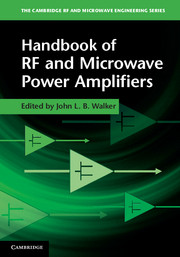Book contents
- Frontmatter
- Contents
- Contributors
- Preface
- 1 Silicon LDMOS and VDMOS transistors
- 2 GaAs FETs – physics, design, and models
- 3 Wide band gap transistors – SiC and GaN – physics, design and models
- 4 Amplifier classes, A to S
- 5 Computer-aided design of power amplifiers
- 6 Practical HF/VHF/UHF RF power amplifier realization
- 7 Microwave hybrid amplifier realization
- 8 Monolithic power amplifiers
- 9 RF power amplifier thermal design
- 10 Reliability
- 11 Power amplifier applications
- 12 Amplifier measurements
- About the authors
- Index
Preface
Published online by Cambridge University Press: 05 November 2011
- Frontmatter
- Contents
- Contributors
- Preface
- 1 Silicon LDMOS and VDMOS transistors
- 2 GaAs FETs – physics, design, and models
- 3 Wide band gap transistors – SiC and GaN – physics, design and models
- 4 Amplifier classes, A to S
- 5 Computer-aided design of power amplifiers
- 6 Practical HF/VHF/UHF RF power amplifier realization
- 7 Microwave hybrid amplifier realization
- 8 Monolithic power amplifiers
- 9 RF power amplifier thermal design
- 10 Reliability
- 11 Power amplifier applications
- 12 Amplifier measurements
- About the authors
- Index
Summary
Preface
In 1989, I was responsible for organizing a workshop at the European Microwave Conference on High-Power Solid State Amplifiers. This workshop proved popular and so Artech House asked me to persuade the speakers to turn their material into a form suitable for publication, the result was the book entitled “High-Power GaAs FET Amplifiers” of which I was editor and a coauthor. That book is of course not just out of print but also largely out of date. This book adopts the same philosophy as the previous one with chapters on device technology, amplifier design, CAD, thermal design, reliability, measurements, and applications – but with a completely different set of authors and with every chapter completely re-written to bring the content up to date.
The political, economic and technical landscape has changed almost beyond recognition in the intervening two decades. In the 1980s most RF and microwave engineers were working in military electronics, defense spending was largely responsible for all the technical advances, and there were no mobile phones! Compare that with the situation now where there are probably just as many RF and microwave engineers working on commercial applications as there are in military electronics, commercial applications often drive technical advances, and most households will have not just one but several mobile phones – and it is the mobile phone industry that has largely been responsible for this shift toward commercial applications. However, there is one consequence of this sea-change in the industrial and technical environment which has had a profound knock-on effect when it comes to writing a book such as this. Now the commercial pressures of shortest possible time to market and minimum cost, etc. are so intense that any prospective author working in this field has to be prepared to commit endless hours of their own rather than their employer's time to the task. I want to publicly acknowledge my deep debt of gratitude to all the authors in this book for making that commitment and hence making this book possible.
- Type
- Chapter
- Information
- Handbook of RF and Microwave Power Amplifiers , pp. xv - xviPublisher: Cambridge University PressPrint publication year: 2011

